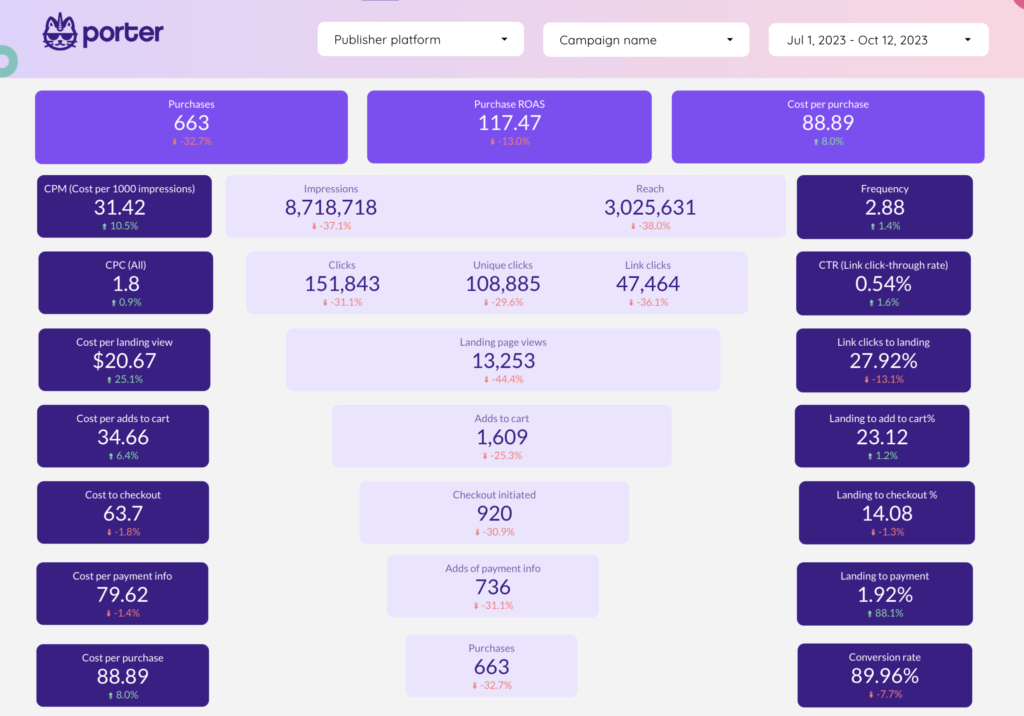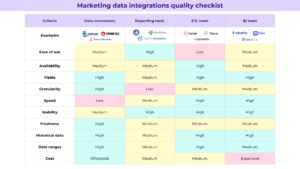DataBox is one of the well-known business analytics platforms in the market. In this article, we discuss some of the Databox alternatives in 2022.
DataBox is used worldwide and generates more than 5 million dollars in revenue annually. They have more than 2000 paying customers, which puts them among the most acclaimed marketing analytics software in the world.
There are unique specifications and features that make DataBox what it is and give it the reputation it has in the market. We have created an in-depth DataBox review for you to read, which will give you more insights in case you do not have that much information about the tool.
In this article, we will talk more about the other tools that can make your business grow if you are unsatisfied with the service you get from DataBox. But first, let’s start with brief information about DataBox.
About DataBox
Databox is an online business intelligence platform that helps you understand what’s going on with your business by collecting all KPIs, spreadsheets, and databases in one place. Integration with various services will also help in this.
The service allows users to create their own analytical dashboards with data from multiple sources. The system is suitable for marketers, analysts, and company executives.
The constructor allows you to create dashboards using a drag-and-drop editor, with the ability to customize the appearance. Users can control additional options for each metric, such as changing time intervals, currencies, and chart formats.
Databox Key Features:
- Drag and drop editor.
- Customizable reports.
- Daily indicators.
- Weekly summaries.
- Mobile Alerts.
- Annotations.
- Favorite metrics.
- User management.
- Permission management.
- Branding customization.
- Multiple data sources.
- IP restrictions.
- Multichannel dashboard view.
- Data visualization.
- Custom metrics, events, and statistics.
- Data modeling.
- Data integration.
What Are the Main Cons of Using DataBox?
There are various cons of using DataBox that a lot of people mentioned in their reviews on different tech platforms. Some of them are:
- It takes a lot of time to set up the tool
- Lack of customizable dates
- Historical data limitations
- Inaccuracies in data from time-to-time
Why Should You Consider the Alternatives For DataBox?
There may be various reasons for you to look for alternatives to DataBox. It can be about their pricing strategies, limitations, or just that you need a change of scenery as you have been using DataBox for quite some time.
Now we will have a look at the main DataBox alternatives and their main characteristics.
DataBox Alternatives
Whatagraph
Whatagraph is a visual reporting tool for marketers, agencies, and businesses. You can aggregate data sources from multiple platforms and connect them to a single source with Whatagraph. Here are the main basic characteristics of Whatagraph:
• From $99
• Solutions for
• White-Labeling
• Automated reporting
This data visualization tool is trusted by well-known brands such as Colgate, Holiday Inn, FILA, Chili, and more. Whatagraph is one of the best ways to visualize the results of your marketing campaigns with data-driven graphs.
Agencies can use Whatagraph to automatically generate weekly, monthly, or quarterly multi-source reports for clients. Another benefit of agency features is the ability to white-label your reports.
Upload your logo and customize the color scheme to present branded images to your customers. Here’s a quick look at Whatagraph pricing plans:
- Professional – $99 per month
- Premium – $239 per month
- Growth – $599 per month
Small businesses and sole marketers can use the Professional plan for basic marketing data. But agencies will be better off with the Premium or Growth options.
Tableau
Another DataBox alternative you should go for in case you are more into BI tools is Tableau. It is best known for its BI capabilities. It ranks first on our list of the best business intelligence software on the market today. Here are the starting points for you:
• Analyze big data
• Pricing starting from $70
• Advanced visual reports
• 14-day free trial
But data visualization is a component of business intelligence. For larger businesses with complex datasets, Tableau will help you analyze this information.
Ultimately, this tool makes it much easier for businesses to make data-driven decisions based on large data sets. You can create basic types of data visualizations with Tableau, for example:
- Graphics
- tables
- infographic
- maps
- Graphics
- boards
But Tableau also offers more complex and tailored ways to visualize your data. Examples:
- Box and Whiskers Graphics
- Bubble Clouds
- Cartograms
- Point Distribution Maps
- Heatmaps
- Histograms
- Stack Charts
The list goes on and on. You can also match combinations of these visual data representations in a dashboard. For basic users, Tableau is probably unnecessary.
However, analytics is ideal for large businesses with big data. Pricing for Tableau starts at $70 per user per month with an annual contract.
Zoho Analytics
Zoho Analytics is a reporting and analytics software for business intelligence. Trusted by HP, Ikea, Hyundai, Philips, and thousands of other brands. Here are the main starting points to consider:
• Starts at $22 per month
• Unlimited reports and dashboards
• Easy to use
• 15-day free trial
• Trial period for free
The software makes it easy for non-technical users to create visually appealing data and insightful dashboards in minutes. Simply upload your data to Zoho Analytics from any data source.
Importing is simple whether it’s a local file, cloud drive, business application, or web URL. Zoho Analytics lets you create charts, pivot tables, and table view components for comprehensive reporting and dashboards.
It has a drag and drop interface, so you can also make custom changes. Collaborating with colleagues and colleagues is easy with Zoho Analytics online collaboration tools.
Embed reports on your website, make them available for offline access, or schedule them to be emailed automatically. Here’s a quick overview of Zoho Analytics pricing:
- Basic – $22 per month
- Standard – $45 per month
- Premium – $112 per month
- Enterprise – $445 per month
Even the basic plan has unlimited reports and dashboards. Zoho Analytics also has a free forever plan, but most business users will find it extremely limited.
SuperMetrics
Another DataBox alternative you should consider is SuperMetrics, an industry giant in the marketing intelligence industry. Here are the main initial features worth considering:
- It offers direct integration with dozens of popular marketing platforms
- Works in tandem with both Google Spreadsheets and Excel
- A chance to visualize your data from many different options and integrate it into dynamic dashboards
- Free trial
Pros of Supermetrics
- It greatly simplifies the data retrieval process and provides additional context by combining different marketing streams in a single hub.
- Several daily updates via Google Spreadsheets create a close simulation of real-time analysis.
- Automation can save you a lot of time.
Disadvantages of Supermetrics
- It still requires occasional manual checking when dealing with complex datasets
- The servers are sometimes unresponsive at rush hour
- Maybe a little bit expensive (Pricing starts from 69$, goes up to 499$ per month)
Brief Review
There are a number of software platforms that allow you to analyze these relationships, but SuperMetrics strives to keep these large and sometimes seemingly impenetrable piles of information and help you find the context in which they interconnect.
The result is a major project that offers a wealth of tools for your marketing team. Many companies have access to the wide range of metrics that they have available, but one of the major problems arises from figuring out how best to interpret this data.
Pages and pages of raw numbers are hard to find meaning for the average person, and the constant influx of new information in most relevant datasets that are manually trying to compile and sort this information can be a full-time job.
SuperMetrics integrates with some of the most important collection platform indicators worldwide, automating the information gathering process.
Supermetrics offers support from more than 40 business platforms that include big names, such as Google Analytics and AdWords. From there, it can automatically compile information in a spreadsheet program such as Google, Spreadsheets, or Excel for analysis and archiving purposes.
Infogram
The 5th alternative on our list is Infogram.
Infogram is a web-based infographic and data visualization platform. It allows you to create and share infographics, maps, and charts by turning all user data into attractive graphics.
After that, you can share, embed or publish these graphics wherever you want. Also, the tool is easy to use and suitable for government agencies, marketing teams, and even students.
The good news is that you don’t need any technical knowledge or coding skills to get started with Infogram. Pricing plans also vary by type of usage, so you don’t have to worry about paying more. And it’s completely free if you want it for basic designs and usage.
Better for:
Infogram is very suitable for organizations working with sales and marketing as it allows you to display your goals with the help of charts and templates. It is also useful for audit firms.
Pros:
- It is incredibly student-friendly as well as useful for institutions and government agencies.
- It provides customizable templates to help you add colors, fonts, logos, and more.
- It offers a wide variety of images, icons, and flags. Appropriate maps and chart sets are available.
- Templates help create social media images, dashboards, and reports.
- It has some nice project templates that can turn data into engaging content.
Cons:
- Your data can be difficult to navigate
- Customer service needs improvement
Prices:
Paid plans start at $19 per month and go up to $149 per month. Then there is a bid-based plan that helps you choose all the features you want based on your business needs. Infogram also offers a free plan for basic features.
DashThis
DashThis is agency reporting software. It is a simple analytics dashboard tool and offers such reporting features that users need to scale their business. It allows users to automate what they want to do quickly and efficiently.
It allows them to customize according to their wishes and provides unlimited access to all features such as data sources, local integrations, and unlimited users.
It is most commonly associated with more than thirty-four popular digital presentation platforms where users can create any promotional tool. The platforms in question include:
- Google Ads
- YouTube
If users create any dashboard, it can consist of data from any integration, and it will automatically update the dashboard. In DashThis, users can add as many customer accounts as needed. They can develop integrations, dashboards, many data sources, page accounts, and integrations.
Users can manage their entire team to access and modify and submit control panels and provide various templates like report templates, custom template, preset widgets duplication options. Users can also save their full report as a template and use it for all their new customers.
The pricing plans start from 39$ per month to 399$ per month, and we can say that it is suited for all types of industries and firms. So if you are looking for a DataBox alternative, DashThis can be the one.
Looker
With the team-oriented Looker’s BI platform, you can create visualizations using a single code and design more complex visualizations from it. You can create and share reports using SQL and design your own analytics modules.
Pros:
- Great customer service.
- Easy to use.
- Simple flow.
- Fast learning curve.
- Quickly edit large data sets.
- Uncomplicated queries.
Cons:
- It lacks certain visualization features – especially in the control panel.
- LDAP integration setup is difficult.
- Limited documentation and help guides.
Pricing: The pricing plans differ, but you will need about $3000/month for ten users. You should have to contact the vendor for accurate details regarding SMB and enterprise edition pricing.


